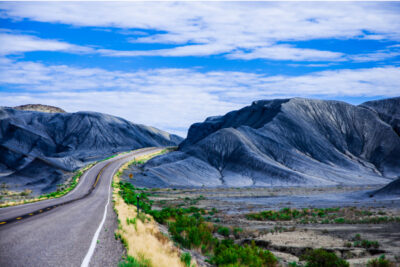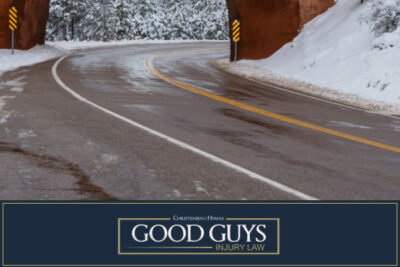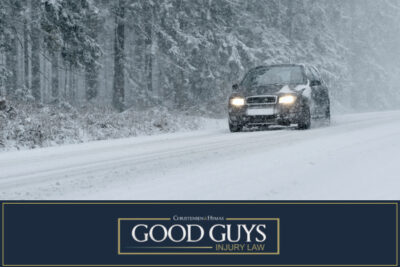
In Utah, road accidents can happen at any time of the year, but one season stands out as particularly dangerous: winter. The combination of holiday traffic, weather, and short days makes this season risky for drivers, pedestrians, and cyclists.
Statistics show a significant increase in road crashes during these colder months, often involving both residents and visitors who may not be familiar with Utah’s challenging driving conditions. Data from 2022 show crash rates spiking in December, with more than 6,000 car accidents reported that month. This is the highest number than any other month in 2022.
At Good Guys Injury Law, we believe that safety should always come first. Understanding the seasonal trends and causes can help us prepare better What do you need to know about seasonal accident trends in Utah?
Table of Contents
Overview of Seasonal Accident Trends in Utah
Utah experiences a clear spike in road crashes during the winter months. Ice and snow affect most of Utah’s roads as temperatures drop, particularly in higher elevations and rural areas.
The Utah Highway Patrol reports increased calls for crashes and slide-offs during this period. This consistent trend underscores the need for heightened caution and preparedness among all road users. Car accidents during the the cold weather can be particularly dangerous.
Factors That Influence Accidents During Different Seasons

Utah’s unique climate and topography mean that weather conditions can vary dramatically from one part of the state to another. In regions like Salt Lake City, heavy snowfall and black ice are common in winter, whereas southern areas may experience milder conditions. Weather changes.
Each season brings different weather conditions that affect driving safety. Snow, spring rains, and autumn leaves create slippery road surfaces that can lead to accidents crashes.
Seasonal changes can significantly impact road safety, as each season presents unique conditions that increase accident risks. From weather and daylight to changes in traffic and road conditions, these factors all influence driving safety throughout the year.
Daylight hours.
Shorter days mean less daylight for driving, increasing the likelihood of accidents occurring in the dark. This is particularly dangerous when combined with rush hour traffic.
Driving behaviors.
Seasonal celebrations, especially during summer and holidays, can lead to a rise in impaired driving. More drivers on the road who may be under the influence mean a higher risk of accidents.
Condition of roads.
Seasonal maintenance issues, such as potholes after winter and spring, can cause unexpected road hazards. Local governments may struggle to keep up with road repairs, adding to the dangers.
Tourism and traffic volume.
Utah’s tourist seasons bring more people onto the roads, especially during winter for skiing and summer for national park visits. Increased traffic volume can lead to congestion and higher accident rates.
These varying conditions affect traffic patterns and road safety, as drivers may encounter sudden changes in road conditions. Tourism also peaks at certain times of the year, particularly during ski season and summer holidays, bringing an influx of drivers unfamiliar with Utah’s roads and weather challenges.
The Most Accident-Prone Season in Salt Lake City
Salt Lake City transforms into a snowy wonderland that, while beautiful, brings numerous driving hazards. The Utah Department of Transportation frequently issues warnings about slick roads and reduced visibility.
Drivers face the dual challenge of navigating snowy conditions and sharing the road with others who may not be prepared for driving. The result is a notable increase in traffic incidents, from minor fender benders to multi-car crashes.
Increased Risk of Car Accidents Due to Snow and Ice
Winter roads in Utah are often slick with ice and packed snow, making them treacherous for the unprepared driver. The Utah Highway Patrol advises all drivers to keep their vehicles well-maintained and to use snow tires or chains when required.
In addition, the presence of black ice, which is nearly invisible on the pavement, further increases the risk of unexpected slides and crashes. This makes distracted driving particularly dangerous.
Challenges of Driving in Winter Storms and Poor Visibility
Driving in winter storms and low visibility can be exceptionally challenging, as weather conditions add a layer of unpredictability to the road. From limited visibility to difficult road surfaces, each factor increases the risk of accidents and requires drivers to exercise extra caution.
Limited visibility.
Snowstorms and fog can drastically reduce a driver’s visibility, making it difficult to see other vehicles and road signs. Headlights and fog lights become essential in these conditions.
Unpredictable road conditions.
Roads can be clear one moment and covered with ice or snow the next, especially on routes that traverse higher elevations or are less frequently traveled.
Navigational challenges.
Weather can obscure road markings and signs, making navigation difficult and increasing the chances of getting lost or making dangerous maneuvers.
Stopping distances.
The stopping distance on snowy or icy roads can be many times that on dry roads. Drivers often underestimate this, leading to collisions.
Vehicle performance.
Cold weather can affect vehicle performance, reducing battery life, thickening engine oil, and decreasing tire pressure, all of which can contribute to breakdowns.
Common Types of Winter Accidents
Here’s a look at the most common types of accidents and how they occur:
- Rear-end collisions. These are common on icy roads where stopping distances are longer than expected. Drivers often follow too closely, not allowing enough room to stop safely.
- Slide-offs. Vehicles frequently slide off icy roads into ditches, guardrails, or other obstacles. This type of accident is more common in rural and mountainous areas of Utah.
- Intersection crashes. If not properly treated with salt and sand, intersections can be icy and dangerous. Drivers may slide through stop signs or red lights, causing collisions.
- Pedestrian accidents. Winter conditions can be especially dangerous for pedestrians, who might slip on ice or be struck by vehicles skidding near crosswalks.
- Multi-vehicle pileups. One accident on highways and major roads can quickly involve multiple vehicles, especially in poor visibility or slippery conditions.
Safety Tips To Follow To Stay Safe During Winter Driving

Winter driving requires extra caution and preparation to be safe on the roads. Icy conditions, limited visibility, and unpredictable weather all make driving more hazardous during the colder months.
- Slow down. Always reduce your speed to match road conditions, no matter the speed limit.
- Increase following distance. To provide ample stopping distance, give yourself more space than usual between your car and the one in front of you.
- Use headlights. Even during daylight hours, using your headlights can help you see and be seen in snowy or foggy conditions.
- Avoid sudden stops. Gradually slow down to stop; sudden braking can lead to skidding.
- Stay home. If conditions are particularly bad, consider staying off the roads until they improve.
- Prepare your vehicle. Ensure your car is winter-ready with proper tires, antifreeze levels, and emergency supplies like blankets and a first-aid kit.
- Know your brakes. Whether you have anti-lock brakes or not, knowing how to use them in snowy conditions can prevent crashes.
How Our Utah Car Accident Lawyer Can Help You After a Winter Crash

If you’re involved in a car crash in Utah during the winter, our skilled car accident lawyers can help you address the various aspects of your claim. We understand the unique challenges of winter accidents and have the expertise to argue effectively for the compensation you deserve.
Our team tirelessly gathers evidence, negotiates with insurance companies, and represents you in court if necessary. By partnering with us, you ensure your rights are protected and your recovery is maximized.
Contact Our Utah Car Accident Lawyer for a Free Case Consultation

Don’t let a winter crash overwhelm you. Good Guys Injury Law offers a free consultation with a top Utah car accident lawyer.
Speeding drivers and adverse weather conditions can increase the risk of human error. It is crucial to drive safely, particularly during the winter months. Accidents with other drivers can lead to serious injuries and fatalities.
Contact us today to schedule a free case consultation.
